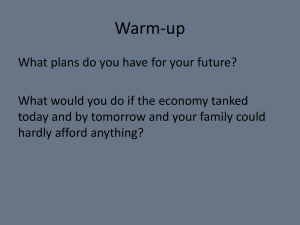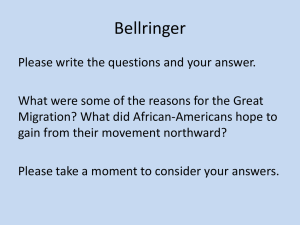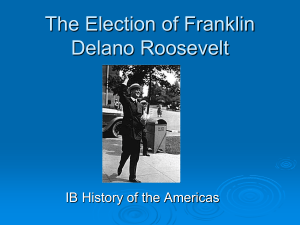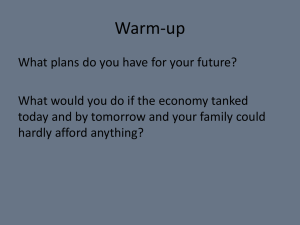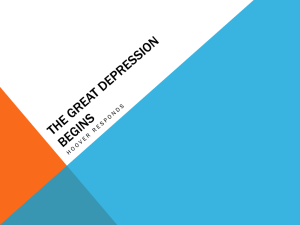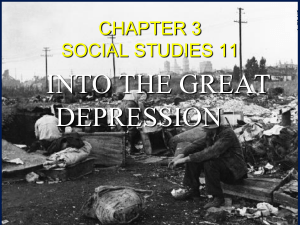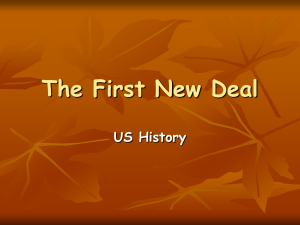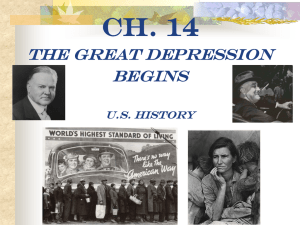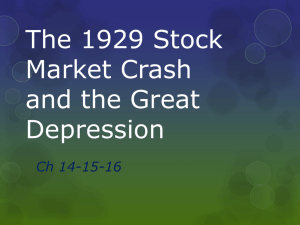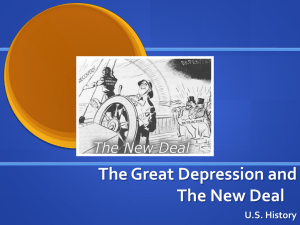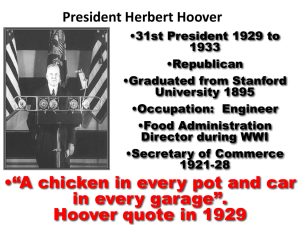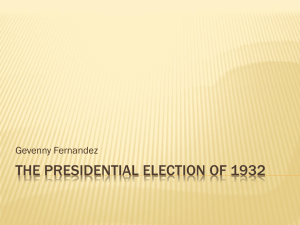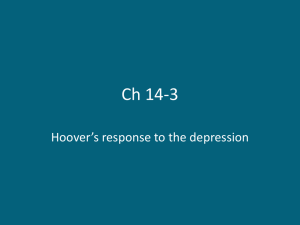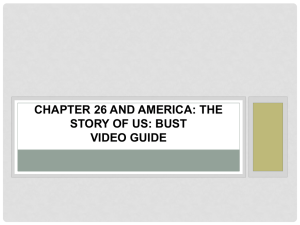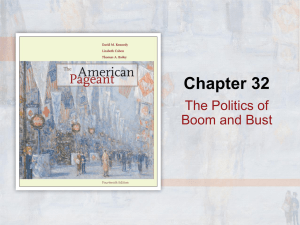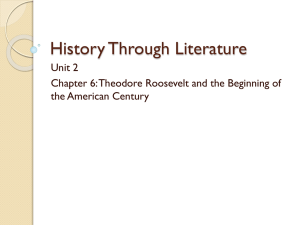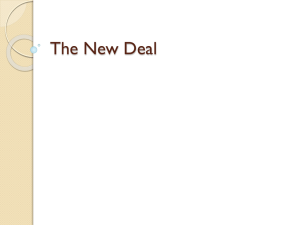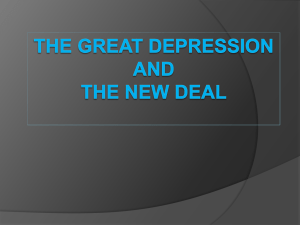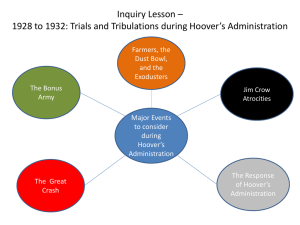FDR and the Great Depression best
advertisement
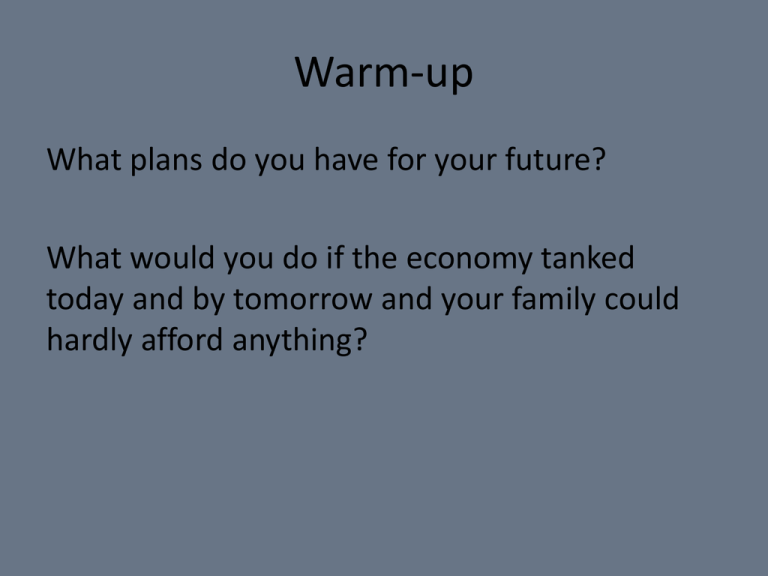
Warm-up What plans do you have for your future? What would you do if the economy tanked today and by tomorrow and your family could hardly afford anything? FDR and the Great Depression In class pgs 628-633 In the election of 1928, what did Herbert Hoover promise the American people? What is a Bull market? What are speculation and Margin, how do they lead to the constantly growing market? Why was Black Tuesday Significant to the stock market? What is a bank run how did the stock market crash lead to Bank Runs? Why did Hoover Create the Haley Smooth tariff? What is it? Di the tariff work? What happened after it was created? Election of 1928 Herbert Hoover who was part of the Coolidge administration ran against Alfred E. Smith of the Democratic party. Hoover said that the wealth and prosperity of the 1920’s was due to the actions of the republican party. This would be how he won the election CAUSES OF THE GREAT DEPRESSION • Tariffs & war debt policies • U.S. demand low, despite factories producing more • Farm sector crisis • Easy credit • Unequal distribution of income Causes of the Depression The twenties saw a boom in consumer spending. As people began to but more durable good such as cars, and refrigerators production began to peter off. Due to the fact that people did not need multiples of these items. Causing a brief recession in 1920s Problems continue to build Not heeding these signs the government continued to make it easier for banks to take out loans. The hope was to stimulate the economy Individuals with excess cash began investing in stock. During the time the market moved in spurts of success. SEEDS OF TROUBLE • By the late 1920s, problems with the economy emerged • Speculation: Too many Americans were engaged in speculation – buying stocks & bonds hoping for a quick profit • Margin: Americans were buying “on margin” – paying a small percentage of a stock’s price as a down payment and borrowing the rest The Stock Market’s bubble was about to break Bull market A Bull market is usually defined as a market on the rise. This rising market only lead more people to invest their money. THE 1929 CRASH • In September the Stock Market had some unusual up & down movements • On October 24, the market took a plunge –”Black Thursday” the worst was yet to come • On October 29, now known as Black Tuesday, the bottom fell out • 16.4 million shares were sold that day – prices plummeted • People who had bought on margin (credit) were stuck with huge debts If you didn’t finish this After the test answer the following I will collect this in fifteen minutes Vertical integration and what company and person used it? Horizontal integration and what person and company used it? 424-426 What state did most Asian Americans come to? What sort of works did the Chinese population do? What law kept the chines out of America? 444-447 What was the social Gospel movement and what was on person from it and one reform? 465-467 What industry were the following people associated with Andrew Carnegie Joh Rockefeller J.P. Morgan Cornelius Vanderbilt 419-426 If your done with this do the following pgs 633- 635 and 640- 643 What was the point of the Hawley Smoot tariff? Was it successful. Explain. What is a hobo? What is the dust bowl? What is a public works? What did the reconstruction Finance company corporation do? What problem did the Bonus army create for Hoover? Warm-upyou have the next twenty minutes to complete until I call you up and check this. 635,643 What conditions cause the dust bowl? What is the dust bowl? Why does the Bonus army form? What happens once the Bonus army reached Washington D.C. 651-653 What did Roosevelt do to fix the gold standard problem? What was the purpose of the bank holidays? What was the importance of the first hundred days of Roosevelt’s presidency? What were the Fire side Chats and why did they happen?? Bank Runs As the stock market crashed people went to the banks to pull their money out of the banks. Do to a fear of a loss of their money. Banks could not handle so many people pulling money out and did not have enough money to give to people The result was the collapse of banks. Unemployment By 1932 the unemployment in the country grew to 25 percent. The unemployed stood in lines for hours looking for relief check. Some left the city for the country, but still found little hope. FARMERS STRUGGLE • No industry suffered as much as agriculture • During World War I European demand for American crops soared • After the war demand plummeted • Farmers increased production sending prices further downward Photo by Dorothea Lange Hoover and Voluntarism Hoover who had a lot of promise as a President was unprepared for the depression. He told the public good things are right around the corner as he supported rugged individualism. Rugged Individualism: the belief that Americans could improve their own standing if they worked hard. He pushed fro charities to give relief, but refused to provide federal funding when supplies ran out. Taking action As Hoover saw his attempts fall apart he began to take action to change the economy. Loaned money to cooperatives and bought access crops. Created the RFC (Regulatory Finance corporation)to help banks. Pushed for the cutting of taxes and built the Hoover dam. Hoover-villes As unemployment and homelessness rose in New York citizens began to camp out in central park. These camps were called hoovervilles in mockery of the President Public works Hoover developed during the depression the idea of a Public Works project Where Hoover would take unemployed laborers to make something to help the general public The finest example being the Hoover Dam Unfortunately this project employed only a small group of workers for a small period of time. Hawley smoot Tariff Hoover wanted increase people buying American goods, to handle this he increased the cost of buying foreign goods with the Hawley Smoot Tariff. This Failed As European countries bought less American products in reaction to the tariff weakening the U.S. Economy further. Bonus Army Only a few weeks before the start of next presidential election veterans of the first world war were supposed to receive money for there service to the country to help deal with the depression When the government could not pay the workers in time they marched on the capital and set up camp. The U.S. Army was brought to force the veterans to leave hurting Hoover public image even more. Roosevelt and the New Deal 1932 the Republicans nominate Herbert Hoover The Democrats Nominate FDR who proposes the new Deal in his acceptance speech The New Deal: A name for the policies that Roosevelt would use to end the depression. Election 1932 Roosevelt’s optimism in the future was a stark contrast to Hoover’s failure. With this perception Roosevelt won by a land slide. The Gold Standard One of the first things Roosevelt did was end the Gold standard The gold standard equated an once of gold to a certain amount of dollars. As the dollar value dropped the people began to cash their money in for gold Confiscating Gold Roosevelt ended the Gold standard and began to collect people’s gold. This was to increase the value of the dollar. It was illegal to have more than a certain amount of Gold. Bank Holiday Banks continued to collapse especially due to the end of gold standard. Governors created the idea of bank holiday. It closed the banks giving them time to seek relief Roosevelt agreed and would help restructure banks. The First Hundred Days The new president sent bill after bill to congress By the end of the first hundred days the president passed 15 bills to help the economy. Fireside Chats As the President worked to restore the banks he used to technology to reassure citizens. Roosevelt took to the radio explaining to the people what his plans were for banks. As well as reassure the American people. Warm-up Define the following new deal organizations starting on page 654-659 HOLC FCA The AAA The NRA The CCC FERA PWA And the success of the First New Deal FDIC and SEC SEC: Securities and Exchange Commission: Existed to manage the stock market and prevent fraud. FDIC: Federal Deposit Insurance Corporation provide government insurance for bank deposits. Built confidence in the bank system. HOLC and FCA HOLC: Home Owners Loan Corporation: Helped homeowners pay their mortgage. FCA: The Farm Credit Administration: Help farmers refinance their mortgages. Warm-up • Read and answer the following starting on pages 662-663 668-673 • What is deficit spending? Why is it so controversial when it comes to FDR? • Why was the American Liberty party formed? • Who are Huey Long and Father Coughlin what points of the new deal are they protesting? Why is Frances Perkins a key figure during the new deal? What does this show us about Franklin Delanor Roosevelt’s presidency What was FDR’S court packing plan? Why might it be controversial? Who is John Meynard Keynes? Why might he be important to the ideas of the New Deal? The AAA and NRA AAA: Agricultural Adjustment Administration, worked to adjust farm prices. NRA: National Recovery Administration: Lead by Hugh Johnson Business owners signed a pledge to sell government products that pushed fair labor environments. Unfortunately the NRA was considered unconstitutional by the Supreme Court and was removed. The CCC and PWA CCC: The Civilian Conservation Corps: Gave young men age 18-25 the chance to work with the forestry service to plant trees and fight forest fires. PWA: Public Works Administration: Most of the those unemployed worked in construction. Gave jobs on buildings, sewers, dams, schools, highways. Critics of the President Many criticized the new deal for deficit spending. Essentially they worried that the President had barrowed too much money instead of balancing the budget. As well as the idea that this spending might send the country into a further depression. Opposition to the New deal American Liberty League: A group formed to organized to oppose the New Deal. Believing the people’s rights and property should be protected from the overreach of FDR’s government. The group may have fractured the Democratic party and FDR’s power base. Huey Long: From Louisiana, Long helped those that were impoverished from his state. The reforms allowed long to build a powerful political machine in the state but it was also corrupt. Long captivated the people and created the share our wealth society meant to redistribute money from the rich to the poor. Father Coughlin: Was a Catholic Priest in Detroit who supported the New Deal but thought the laws did not go far enough. Coughlin wanted far more liberal reforms. Second New Deal In spite of all the critics and the constant threat of the Supreme Court of finding the New Deal unconstitutional. FDR moved forward to create the second new deal based on more social assistance programs. WPA The Works Progress Administration: Headed by Harry Hopkins was the largest publics work program of the New Deal Employed workers to build roads and highways. Continued Social Reform When congress came together in 1935 congress was reminded that it had not provided a welfare system for its aged and disabled. Eventually this would become the social security act Provided old age pensions Set up a system of unemployment Provided federal grants for state welfare. Dust Bowl Throughout the late twenties and 1930’s farmers over farming over the decades lead to large amounts of infertile farm land and loose soil. The result was large sand storms that created large dust clouds which cover farms for days The Dust Bowl as it was referred to normally put out two to three dust storms a month. 1. In the late 1920’s many investors engaged in speculation or purchasing stock: A. After considering the companies earnings and profits. B. And quickly selling the stock for a profit C. By barrowing money from a stock broker D. To invest long term in the future of the company. 2. ______ most often traveled by hopping railroad cars. A. B. C. D. Photographer Journalist The homeless hobo 3. Herbert Hoover opposed _____, or giving money directly to needy families. A. B. C. D. Foreclosure Relief Public Works Unionization 4. One of the major problems, with the stock market in the late 1920’s was the number of people who bought stocks. A. B. C. D. On margin, with barrowed money In companies that they supported Only after carefully studying a company’s history Without knowing their stock brokers reputation 5. Which of the following was the root of the Great Depression? A. B. C. D. Prohibiting alcohol Giving women the right to vote Uneven distribution of income End of Federal control of banks 6. Herbert Hoover won the election of 1928 in a landslide in part, because of A. B. C. D. Fears od another world war prosperity under Calvin Coolidge Having been vice president His support of the unions 7. Drought and _____ brought about conditions that caused the Dust Bowl. A. B. C. D. Overgrazing at large cattle farms Near extinction of the buffalo Famine Poor farming choices 8. The people who lost their homes in the Great Depression sometimes lived: A. In shanty towns B. Roadside motels C. On the lawn of the U.S. Capitol D. In public libraries opened to them 9. Despite the poverty of the 1930’s more than 60 million people went to the movies weekly. Why were movies so popular? A. Special effects used in movies then were amazing B. People could not get over the fact that the actors talked C. Movies offered an escape from viewers hard lives D. Theaters were in air conditioned and offered free popcorn. 10. Hoover was slow to respond to the economic crisis because: A. B. C. D. All public works projects Deficit Spending Investing in stock Private charities 11. The Federal Government began building Hoover Dam in 1931. What body of water was it designed to control? A. B. C. D. The Pacific Ocean Lake Powell The Great Salt Lake The Colorado River 12. Which State benefited most from the hydroelectric power of Hoover dam? A. B. C. D. Utah California Nevada Arizona 13. The purpose of ______ was to prevent banks from being closed completely because of bank runs. A. B. C. D. New Deal Bank Holiday Gold Standard Fireside Chats 13. The period of intense congressional activity after FDR took office was known as the A. B. C. D. Square Deal New Deal Hundred Days Securities and exchange commission 14.____ involves barrowing money to pay fro government programs A. B. C. D. Deficit Spending The gold standard State’s Rights Binding Arbitration 15. Roosevelt ran into major opposition to his ___ plan. A. B. C. D. Broker state Gold standard Recovery Court packing 16. _____ was created to protect bank deposits A. B. C. D. Agricultural Adjustment Act Home Owners Loan Corporation Securities and Exchange Commission Federal Deposit Insurance Corporation 17.To __, the Agricultural Adjustment Act paid farmers not to grow certain crops. A. B. C. D. Raise farm prices Lower farm prices Feed the homeless Let farmers relax 18.The _____ provided work for unemployed young men, who planted trees and built reservoirs. A. Civil Works Administration B. Public Works Administration C. Civilian Conservation Corps D. Federal Emergency Relief Administration Look at pages 663-667 What groups did the New Deal help and who were some of the key leaders of these groups. First Hundred Days
